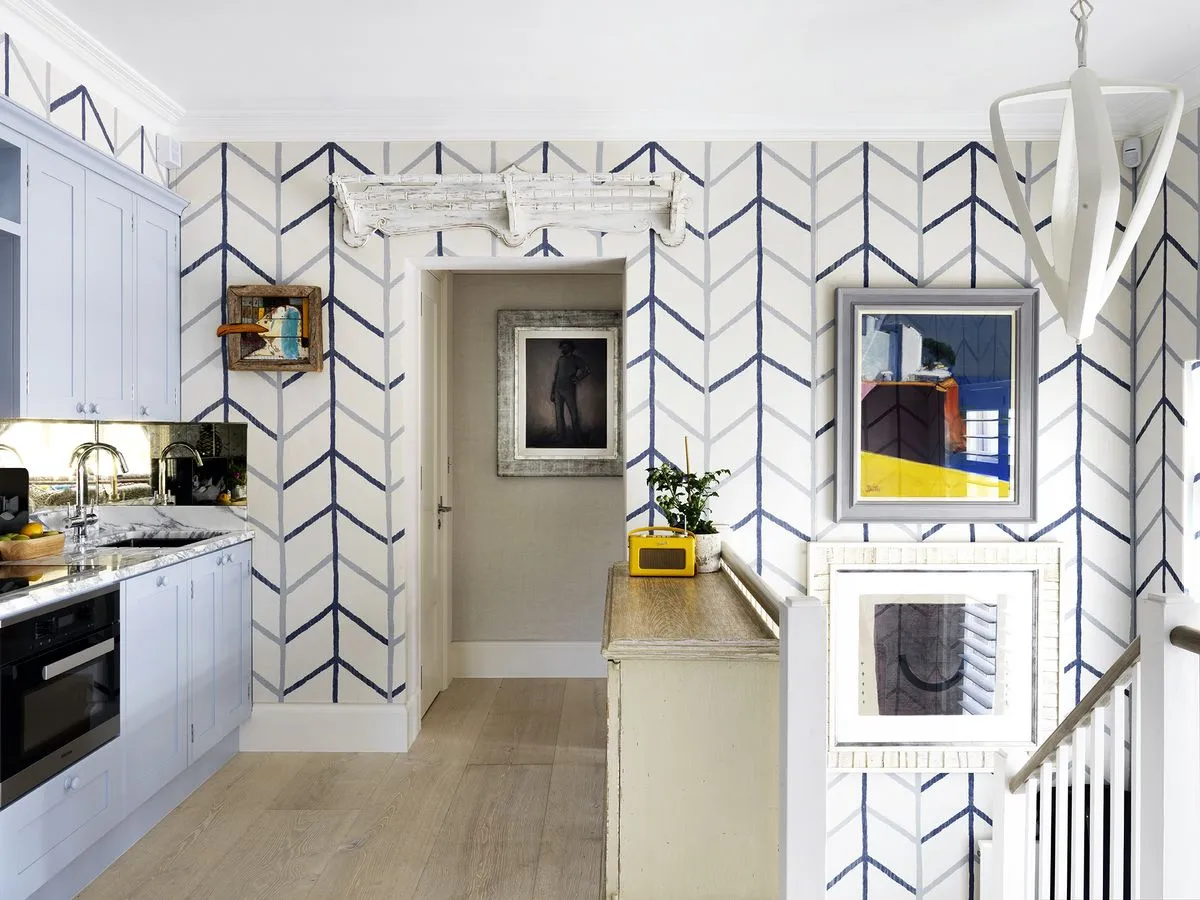Choosing the Perfect Blue for Your Kitchen
Transforming your kitchen with blue hues can create a calming and visually appealing space. However, selecting the right shade of blue is crucial to achieve the desired ambiance. The ideal blue for your kitchen depends on various factors, including natural light, the overall style of your home, and personal preferences. Considering these elements will help you create a cohesive and inviting kitchen design. The right blue can make your kitchen feel larger, brighter, and more welcoming. Choosing the right blue for your kitchen is an essential first step toward creating a space you’ll love.
Understanding Blue Hues and Undertones
Blue paints come in a vast array of hues, each with its unique character. Hues refer to the pure color, while undertones are the subtle colors mixed in, which greatly affect how the blue appears in your kitchen. For instance, some blues have green undertones, making them appear cooler and more vibrant, while others have gray undertones, resulting in a softer, more muted look. Understanding these undertones is key to predicting how the color will interact with the existing elements of your kitchen, such as flooring, countertops, and natural light. Test paint samples in different areas of your kitchen to see how the light influences the color throughout the day.
The Impact of Light on Blue Paint
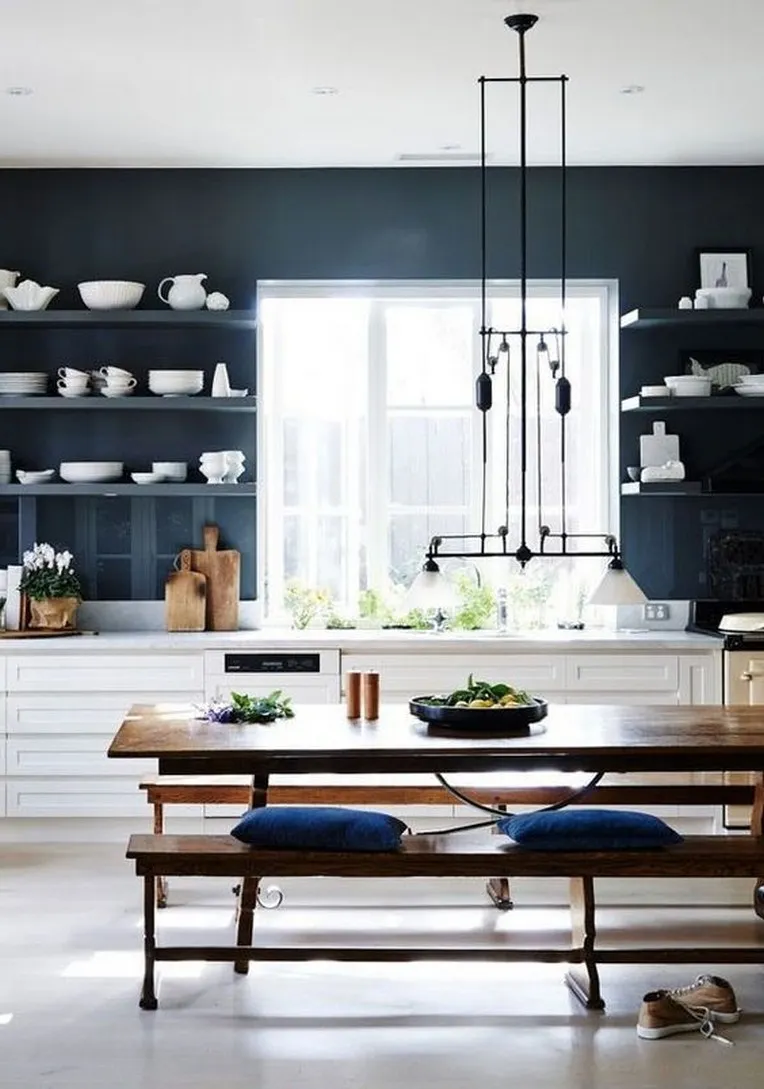
The amount and type of light in your kitchen play a significant role in how blue paint appears. Natural light can make blue appear brighter and more vivid, while artificial light can alter its appearance, sometimes bringing out undertones you might not have noticed otherwise. In kitchens with ample natural light, you can experiment with deeper, richer blues. Conversely, in kitchens with less natural light, lighter blues can help create a brighter, more open feel. Consider the direction your windows face; south-facing rooms receive warm light, which can enhance blues, while north-facing rooms receive cooler light, which may make blues appear more subdued.
Selecting the Right Blue for Your Kitchen Size
The size of your kitchen is another important factor when choosing a blue paint color. Lighter blues tend to make a space feel larger and more airy, making them ideal for small kitchens. They reflect light, which visually expands the room. Darker blues can work well in larger kitchens, adding depth and creating a sense of coziness. However, if you have a small kitchen and prefer a darker blue, consider using it as an accent color on a feature wall to avoid overwhelming the space. Think about the overall flow of your home; if your kitchen opens to other living areas, ensure the blue complements the existing color scheme.
Blue Kitchen Decor Ideas Paint Colors
Once you understand how to choose the right blue, it is time to explore specific paint colors. Different shades of blue evoke different moods and offer distinct design possibilities. From tranquil to energetic, the right blue can transform your kitchen into a space that reflects your personality and meets your needs. The paint color you choose can have a significant impact on the overall look and feel of your kitchen, so it’s worth exploring various options to find the perfect match for your vision.
Popular Blue Paint Colors for Kitchens
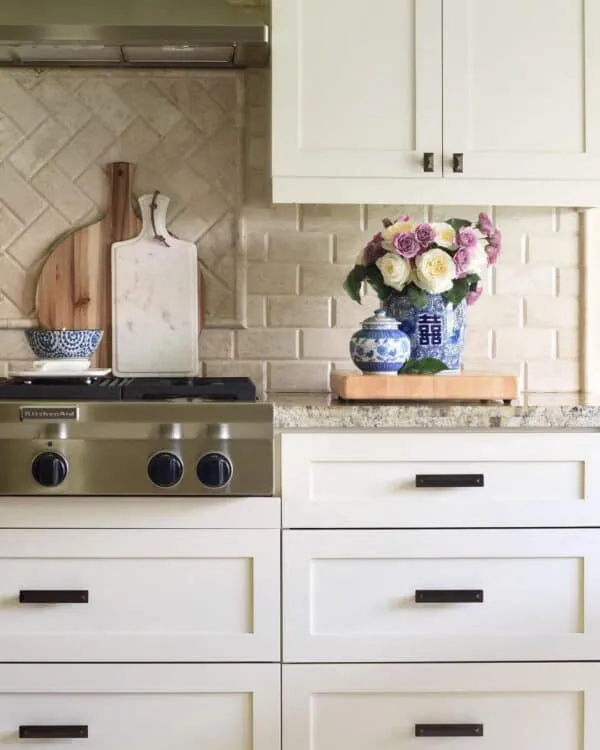
Several blue paint colors have gained popularity for kitchens due to their versatility and aesthetic appeal. These colors offer a range of options to suit different styles and preferences. Popular choices include serene sky blues, classic navy blues, and modern gray-blues. These colors each provide a unique character, enabling you to create a distinct atmosphere in your kitchen. Some blues are more subdued, promoting a sense of calmness, while others are more vibrant, injecting energy into the space. Researching these popular choices can help you find the perfect shade for your kitchen.
Classic Navy Blue
Navy blue is a timeless choice that adds sophistication and depth to any kitchen. It works particularly well in spaces with ample natural light, creating a rich, inviting atmosphere. It can be paired with white trim and stainless-steel appliances for a clean, modern look, or with gold accents for a touch of luxury. Navy blue is also a great option for kitchen cabinets, providing a bold statement and a sense of elegance. Remember that navy can make a space feel smaller if not balanced with lighter elements, so consider light countertops or a bright backsplash to offset the darkness.
Serene Sky Blue
Sky blue evokes a sense of calm and tranquility, making it an ideal choice for creating a relaxing kitchen environment. It’s a versatile color that works well in various kitchen styles, from farmhouse to coastal. Sky blue pairs beautifully with white, natural wood tones, and pastel accents, enhancing the airy feel. This shade is particularly effective in smaller kitchens, where it can create the illusion of more space. It reflects light and can make a kitchen feel brighter and more open. Consider sky blue for walls, cabinets, or even as an accent color on an island.
Modern Gray-Blue
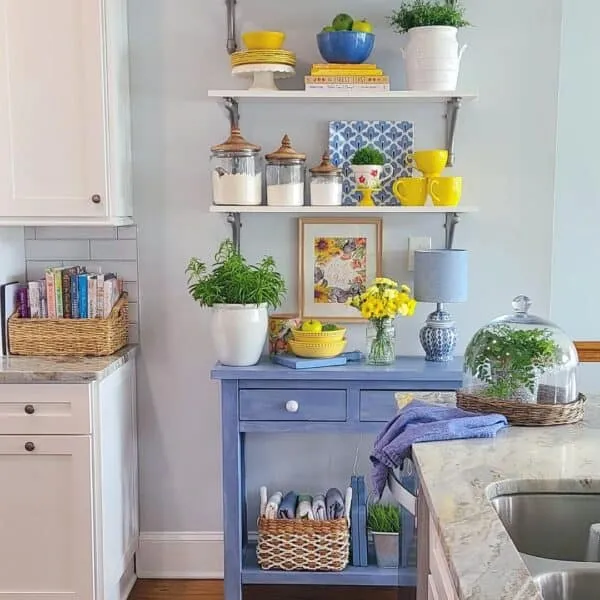
Gray-blue blends the sophistication of gray with the calming qualities of blue, offering a contemporary and stylish look. It’s a versatile color that complements both modern and traditional designs. Gray-blue provides a subtle backdrop that works well with various accent colors and materials. It can be used on walls, cabinets, or even as a statement on an island. This color is particularly suited to kitchens with stainless-steel appliances and sleek, minimalist designs. Gray-blue is an excellent choice if you want a neutral yet interesting color.
Coordinating Colors with Blue Kitchens
Choosing the right complementary colors is essential for creating a harmonious and visually appealing blue kitchen. Color combinations can significantly impact the overall look and feel of your kitchen. Consider the mood you want to achieve and the existing elements of your kitchen, such as flooring and countertops. Selecting the right color scheme enhances the blue and creates a cohesive design. By understanding the best color pairings, you can create a kitchen that is both stylish and functional.
Color Schemes that Complement Blue
Several color schemes pair exceptionally well with blue, offering a range of design possibilities. These combinations can help enhance the blue’s aesthetic appeal and create a cohesive kitchen design. The best color scheme depends on the shade of blue you choose and the style you want to achieve. You can experiment with different color combinations to find the perfect look for your kitchen, ensuring that your design reflects your personality and meets your needs. Carefully chosen color schemes bring balance, harmony, and visual interest to your space.
White and Blue Combinations
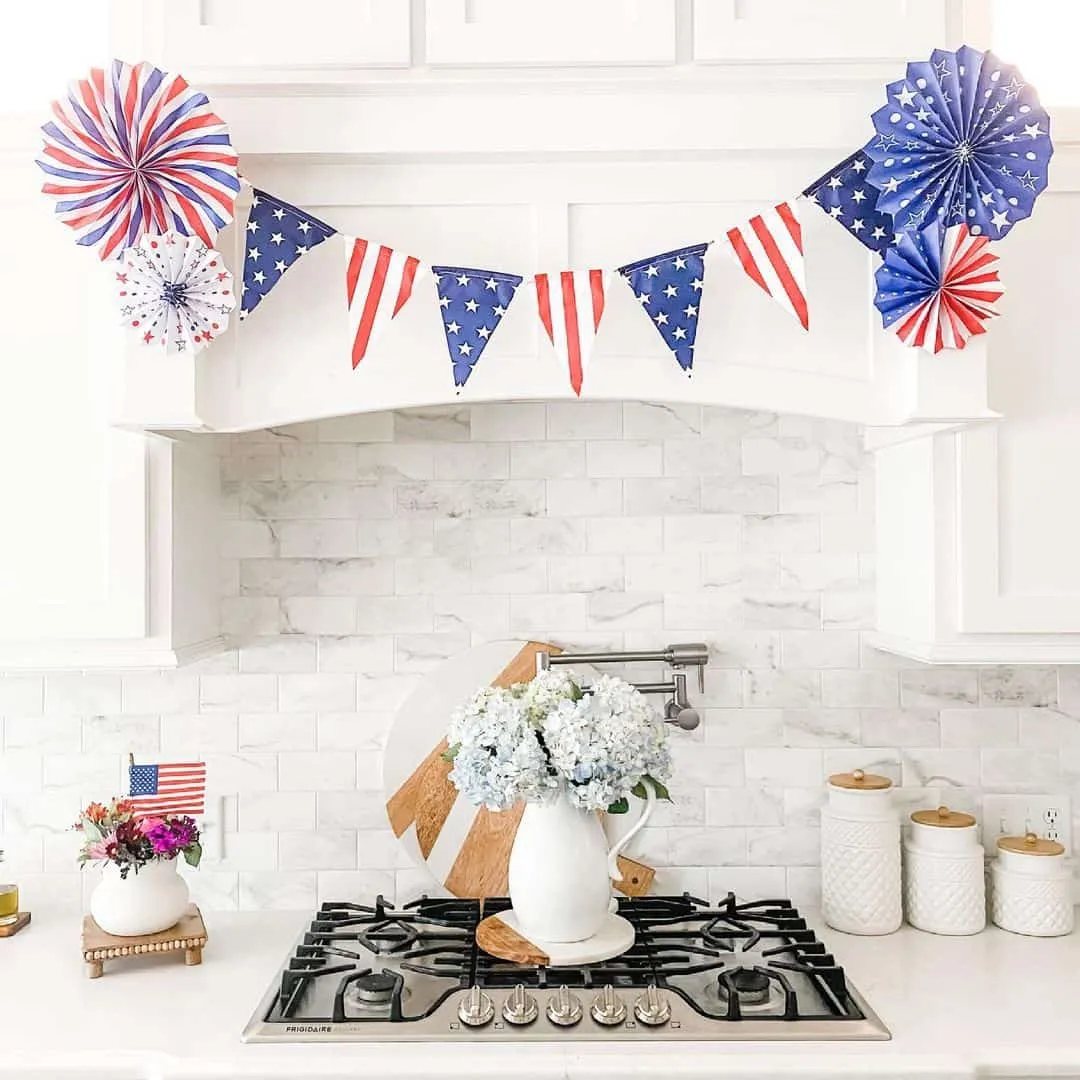
White and blue is a classic combination that creates a fresh, clean, and timeless look. White walls and cabinets provide a bright backdrop that makes the blue accents pop. This pairing works well with any shade of blue, from light sky blues to deep navy. White kitchens with blue islands or backsplashes are particularly popular. Add pops of color with accessories to complete the look. This pairing also makes the kitchen feel larger and more open, especially in smaller spaces. Consider using white as the primary color and blue as an accent for a balanced look.
Gray and Blue Pairings
Gray and blue create a sophisticated and modern aesthetic. The combination is versatile and complements various design styles. Gray provides a neutral base that allows the blue to shine. This pairing works especially well with gray-blue paints, creating a cohesive and calming atmosphere. Consider using gray on walls and blue on cabinets or vice versa, for a balanced look. The gray provides depth and the blue brings in brightness. This combination works perfectly to make a kitchen look more contemporary and stylish.
Wooden Accents with Blue Kitchens
Incorporating wooden accents into a blue kitchen can add warmth and natural texture. The contrast between the cool blue and the warm wood tones creates a balanced and inviting space. Wooden elements can be introduced through flooring, countertops, open shelving, or kitchen accessories. Lighter wood tones, such as oak or maple, create a brighter, more airy feel, while darker woods, like walnut, add a touch of luxury and sophistication. Wood can add a touch of earthiness and create a more welcoming environment. Combining wood with blue creates a harmonious and visually appealing design.
Incorporating Blue Decor into Your Kitchen
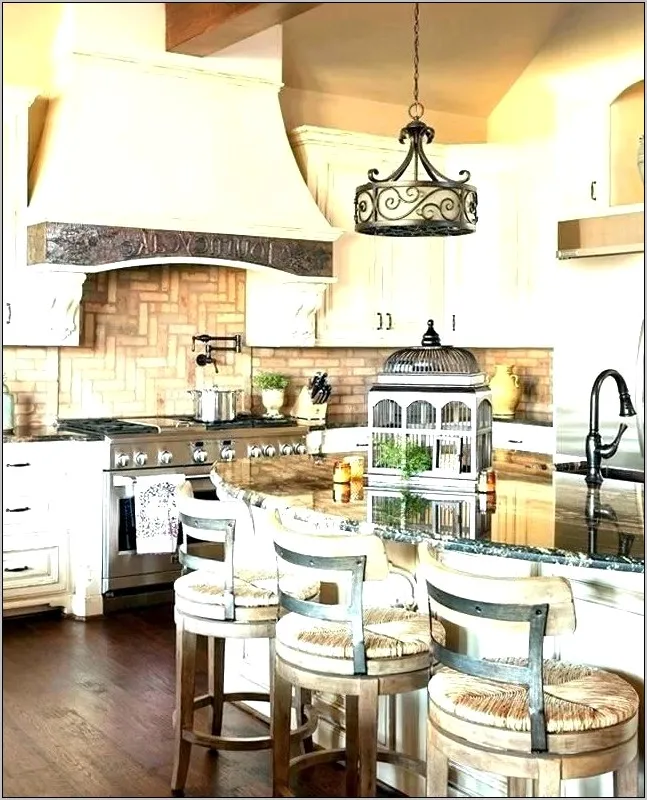
Beyond paint, there are many ways to incorporate blue into your kitchen decor. Blue accents can add personality, visual interest, and a cohesive design aesthetic. Choosing the right decor elements enhances the overall style and creates a welcoming atmosphere. From kitchen cabinets to accessories, various options are available to inject blue into your cooking space. By strategically using blue decor, you can transform your kitchen into a stylish and personalized space, reflecting your taste and preferences. It’s about finding the perfect balance and creating a space that you love.
Blue Kitchen Cabinets
Blue kitchen cabinets can make a bold and stylish statement. They serve as a focal point in the kitchen, creating a vibrant and inviting atmosphere. Various shades of blue work well on cabinets, from light and airy to deep and dramatic. If you prefer a more subtle approach, consider painting the lower cabinets blue and keeping the uppers white or a neutral color. To maintain visual balance, pair blue cabinets with light countertops and backsplashes. Blue cabinets can also be used in combination with different hardware styles, enabling you to achieve a customized, cohesive design.
Blue Backsplashes
A blue backsplash can add a touch of color and visual interest to your kitchen. It can be a great way to introduce blue without painting the entire kitchen. Backsplashes come in a wide variety of materials, from tiles to glass, and each material offers a unique aesthetic. Blue subway tiles create a classic, timeless look, while mosaic tiles add texture and visual appeal. Consider a patterned backsplash to create a focal point or a solid blue backsplash for a clean and modern look. This area is the perfect place to introduce a pop of blue while adding functionality.
Blue Kitchen Accessories
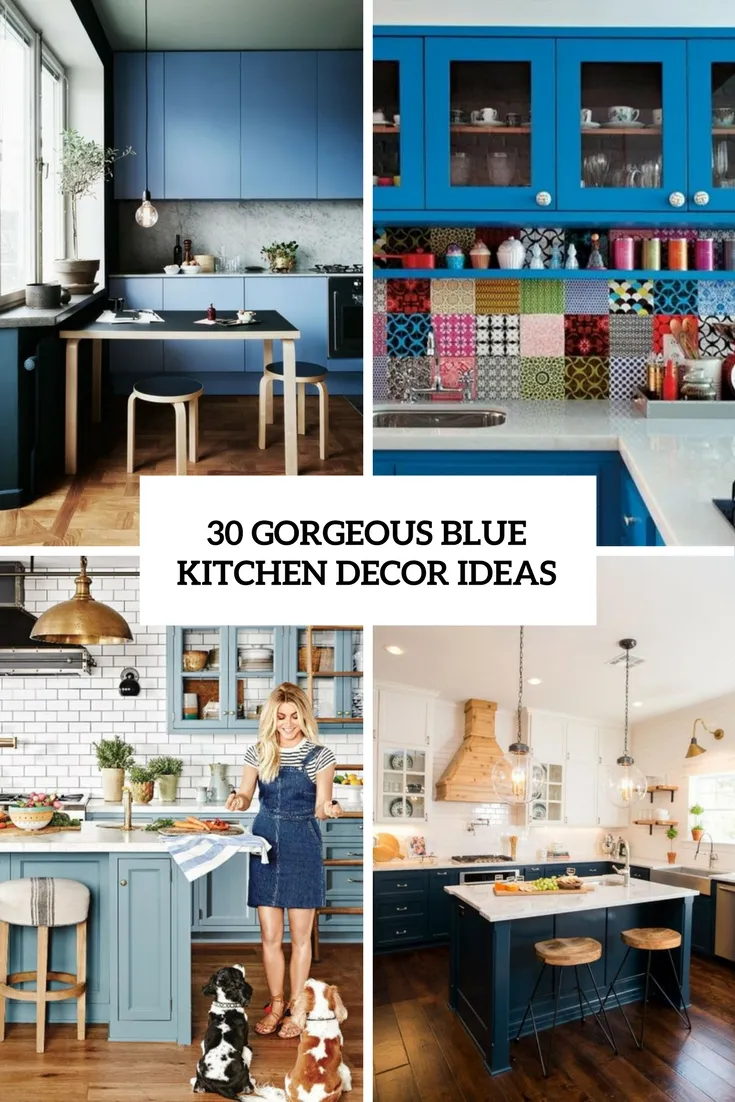
Adding blue accessories to your kitchen is an easy and cost-effective way to incorporate the color. Small touches of blue, like dish towels, vases, or canisters, can make a big difference. Consider blue appliances, such as stand mixers or blenders, to add a pop of color to your countertops. Blue artwork or wall decor can also introduce the color while reflecting your personality and style. Experiment with different shades of blue and textures to create visual interest. Accessories give you flexibility, as you can easily swap them out if you want to change your kitchen’s color scheme.
Creating a Cohesive Blue Kitchen Design
Creating a cohesive blue kitchen design requires careful planning and attention to detail. It’s essential to consider all elements of the space, from paint colors to decor accessories, to achieve a unified look. Focusing on the overall style, balancing colors and textures, and considering the lighting are all crucial steps in creating a space that reflects your style and meets your needs. Planning each detail can transform your kitchen into a beautiful and functional space that reflects your unique style.
Considering the Overall Style of Your Kitchen
The overall style of your kitchen should guide your design choices. Consider your home’s existing style and your personal preferences. For example, a modern kitchen might feature sleek blue cabinets paired with stainless-steel appliances and minimalist decor. A farmhouse kitchen could incorporate sky-blue cabinets with wooden accents and rustic decor. A coastal kitchen would look best with light blue walls, white trim, and natural wood tones. Choosing the right style helps you coordinate colors, materials, and decor. Selecting the right style is essential in achieving a cohesive design.
Balancing Blue with Other Colors and Textures
Balancing blue with other colors and textures is key to creating a visually appealing kitchen design. A balanced approach prevents the space from feeling overwhelming and ensures that your kitchen is both stylish and comfortable. Consider the color wheel and choose complementary colors to create harmony. Add textures, such as wood, stone, or metal, to create visual interest and depth. Combining different materials and textures can also prevent the space from feeling flat. Careful planning will create an inviting and visually appealing kitchen.
The Importance of Lighting in a Blue Kitchen
Lighting plays a critical role in a blue kitchen, affecting how the color appears and the overall ambiance. Proper lighting can enhance the beauty of blue and make the kitchen feel inviting. Incorporate a mix of lighting types, including ambient, task, and accent lighting. Ambient lighting provides general illumination, while task lighting focuses on specific areas, such as countertops and the stovetop. Accent lighting highlights architectural features or decor. Choose light fixtures that complement your kitchen’s style. The appropriate lighting enhances the blue tones, making the space more beautiful and functional.
